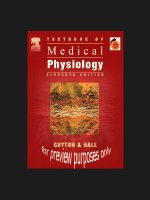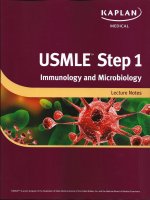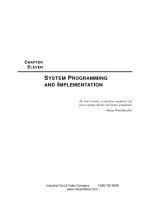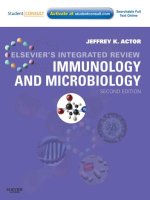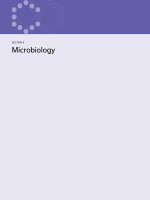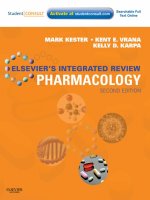Ebook Elseviers integrated review immunology and microbiology with student consult online access (2nd edition) Part 1
Bạn đang xem bản rút gọn của tài liệu. Xem và tải ngay bản đầy đủ của tài liệu tại đây (12.71 MB, 107 trang )
ELSEVIER’S INTEGRATED REVIEW
IMMUNOLOGY AND
MICROBIOLOGY
Intentionally left as blank
ELSEVIER’S INTEGRATED REVIEW
IMMUNOLOGY AND
MICROBIOLOGY
SECOND EDITION
Jeffrey K. Actor, PhD
Professor
Department of Pathology and Laboratory Medicine
University of Texas-Houston Medical School
Houston, Texas
1600 John F. Kennedy Blvd. Ste 1800
Philadelphia, PA 19103-2899
ELSEVIER’S INTEGRATED REVIEW IMMUNOLOGY
AND MICROBIOLOGY, SECOND EDITION
ISBN: 978-0-323-07447-6
Copyright # 2012 by Saunders, an imprint of Elsevier Inc.
Copyright # 2007 by Mosby, Inc., an affiliate of Elsevier Inc.
No part of this publication may be reproduced or transmitted in any form or by any means, electronic or
mechanical, including photocopying, recording, or any information storage and retrieval system, without
permission in writing from the publisher. Details on how to seek permission, further information about the
Publisher’s permissions policies and our arrangements with organizations such as the Copyright Clearance
Center and the Copyright Licensing Agency, can be found at our website: www.elsevier.com/permissions.
This book and the individual contributions contained in it are protected under copyright by the Publisher
(other than as may be noted herein).
Notices
Knowledge and best practice in this field are constantly changing. As new research and experience
broaden our understanding, changes in research methods, professional practices, or medical
treatment may become necessary.
Practitioners and researchers must always rely on their own experience and knowledge in
evaluating and using any information, methods, compounds, or experiments described herein. In
using such information or methods they should be mindful of their own safety and the safety of others,
including parties for whom they have a professional responsibility.
With respect to any drug or pharmaceutical products identified, readers are advised to check the
most current information provided (i) on procedures featured or (ii) by the manufacturer of each
product to be administered, to verify the recommended dose or formula, the method and duration of
administration, and contraindications. It is the responsibility of practitioners, relying on their own
experience and knowledge of their patients, to make diagnoses, to determine dosages and the best
treatment for each individual patient, and to take all appropriate safety precautions.
To the fullest extent of the law, neither the Publisher nor the authors, contributors, or editors,
assume any liability for any injury and/or damage to persons or property as a matter of products
liability, negligence or otherwise, or from any use or operation of any methods, products, instructions,
or ideas contained in the material herein.
Library of Congress Cataloging-in-Publication Data
Actor, Jeffrey K.
Elsevier’s integrated review immunology and microbiology / Jeffrey K.
Actor. – 2nd ed.
p. ; cm.
Integrated review immunology and microbiology
Rev. ed. of: Elsevier’s integrated immunology and microbiology / Jeffrey K. Actor. c2007.
Includes index.
ISBN 978-0-323-07447-6 (pbk. : alk. paper)
I. Actor, Jeffrey K. Elsevier’s integrated immunology and microbiology. II. Title. III. Title: Integrated
review immunology and microbiology.
[DNLM: 1. Immune System Phenomena. 2. Microbiological Phenomena. QW 540]
616.07’9–dc23
Acquisitions Editor: Madelene Hyde
Developmental Editor: Andrew Hall
Publishing Services Manager: Patricia Tannian
Team Manager: Hemamalini Rajendrababu
Project Manager: Antony Prince
Designer: Steven Stave
Printed in China
Last digit is the print number: 9 8 7 6 5 4 3 2 1
2011018052
To my father, Paul Actor, PhD, who instilled in me a sense of excitement about the
wonders of science and the curiosity to ask questions about biological systems
Intentionally left as blank
Preface
Immunology represents a rapidly changing field with new theories actively evolving as molecular techniques broaden our
scientific perspective on interactions between pathogens and
the human host. The immune cells and organs of the body
comprise the primary defense system against invasion by microorganisms. A functional immune system confers a state
of health through effective immune surveillance and elimination of infectious agents. The study of immunologic and hematologic principles, as applied toward understanding host
protection against pathogenic assault, integrates well with microbiology and the study of basic concepts underlying the nature of foreign pathogens. The goal of the first half of the book
is to present immune system components, both innate and
adaptive, in a concise manner to elucidate their intertwined
relationships that culminate in effective host protection and
health. The remaining chapters present the world of microbiology, with a concise overview of clinically relevant bacteria,
viruses, fungi, and parasites, to allow an understanding of infectious organisms as the causative agents underlying human
disease.
This book is aimed at students of human health and those in
the medical profession; it is written to simplify concepts and
encourage inquisitive individuals to explore further medically
relevant topics. Indeed, the purpose of the integrated text
series is to encourage cross-disciplinary thought across multiple sciences. Integration boxes promote cross-discipline
thinking and allow the reader to build bridges between related
ideas in other medical fields. The clinical vignettes (Case Studies)
and associated questions at the end of the book are organized to
provide perspectives into molecular aspects underlying clinical
disease manifestation. These scenarios are aimed to assist in
understanding consequences of ineffective, inappropriate, overactive, or nonregulated responses and their relationship to immunologic disorders and deficiencies as well as to responses
occurring during infection. The associated USMLE format questions available at www.StudentConsult.com will also test
knowledge in a clinical context, with succinct explanations to allow increased application of immunologic and microbiologic
concepts to medically related disease states.
Overall, the text attempts to present information in a clinically relevant and focused manner that outlines concepts for
further exploration, creating a base of knowledge for those
with a desire to understand how the healthy individual combats disease.
Jeffrey K. Actor, PhD
Intentionally left as blank
Editorial Review Board
Chief Series Advisor
J. Hurley Myers, PhD
Professor Emeritus of Physiology and Medicine
Southern Illinois University School of Medicine;
President and CEO
DxR Development Group, Inc.
Carbondale, Illinois
Anatomy and Embryology
Thomas R. Gest, PhD
University of Michigan Medical School
Division of Anatomical Sciences
Office of Medical Education
Ann Arbor, Michigan
Biochemistry
John W. Baynes, MS, PhD
Graduate Science Research Center
University of South Carolina
Columbia, South Carolina
Marek Dominiczak, MD, PhD, FRCPath, FRCP(Glas)
Clinical Biochemistry Service
NHS Greater Glasgow and Clyde
Gartnavel General Hospital
Glasgow, United Kingdom
Clinical Medicine
Ted O’Connell, MD
Clinical Instructor
David Geffen School of Medicine
UCLA;
Program Director
Woodland Hills Family Medicine Residency Program
Woodland Hills, California
Genetics
Neil E. Lamb, PhD
Director of Educational Outreach
Hudson Alpha Institute for Biotechnology
Huntsville, Alabama;
Adjunct Professor
Department of Human Genetics
Emory University
Atlanta, Georgia
Histology
Leslie P. Gartner, PhD
Professor of Anatomy
Department of Biomedical Sciences
Baltimore College of Dental Surgery
Dental School
University of Maryland at Baltimore
Baltimore, Maryland
James L. Hiatt, PhD
Professor Emeritus
Department of Biomedical Sciences
Baltimore College of Dental Surgery
Dental School
University of Maryland at Baltimore
Baltimore, Maryland
Immunology
Darren G. Woodside, PhD
Principal Scientist
Drug Discovery
Encysive Pharmaceuticals, Inc.
Houston, Texas
Microbiology
Richard C. Hunt, MA, PhD
Professor of Pathology, Microbiology, and Immunology
Director of the Biomedical Sciences Graduate Program
Department of Pathology and Microbiology
University of South Carolina School of Medicine
Columbia, South Carolina
Neuroscience
Cristian Stefan, MD
Associate Professor
Department of Cell Biology
University of Massachusetts Medical School
Worcester, Massachusetts
Pathology
Peter G. Anderson, DVM, PhD
Professor and Director of Pathology Undergraduate
Education, Department of Pathology
University of Alabama at Birmingham
Birmingham, Alabama
x
Editorial Review Board
Pharmacology
Michael M. White, PhD
Professor Department of Pharmacology and Physiology
Drexel University College of Medicine
Philadelphia, Pennsylvania
Physiology
Joel Michael, PhD
Department of Molecular Biophysics and Physiology
Rush Medical College
Chicago, Illinois
Acknowledgments
I would like to thank Robert L. Hunter Jr, MD, PhD; Steven
J. Norris, PhD; and Gailen D. Marshall, MD, PhD, who supported and encouraged me as I strove to reach my academic
and research goals. Special thanks go to Alexandra Stibbe
at Elsevier for her vision and insights that made the Integrated
Series possible, to Kate Dimock for her excellent leadership in
the project, and to Andrew C. Hall for his attention to detail,
his humor, and his positive guidance. Finally, I could not have
completed this endeavor without the support of my wife Lori
and her continued faith in my abilities and encouragement to
follow my dreams.
Intentionally left as blank
Contents
SECTION I IMMUNOLOGY
1 Introduction to Immunity and Immune Systems
3
2 Cells and Organs of the Immune System
7
3 Humoral Immunity: Antibody Recognition of Antigen
17
4 T-Cell Immunity
25
5 Role of Major Histocompatibility Complex in the Immune Response
33
6 Innate Immunity
43
7 Adaptive Immune Response and Hypersensitivity
53
8 Immunomodulation
61
9 Immunoassays
71
10 Infection and Immunity
81
SECTION II MICROBIOLOGY
11 Basic Bacteriology
93
12 Clinical Bacteriology
105
13 Basic Virology
121
14 Clinical Virology
129
15 Mycology
139
16 Parasitology
147
Case Studies
157
Case Study Answers
161
Index
167
Intentionally left as blank
Series Preface
How to Use This Book
The idea for Elsevier’s Integrated Series came about at a
seminar on the USMLE Step 1 Exam at an American Medical
Student Association (AMSA) meeting. We noticed that the
discussion between faculty and students focused on how the
exams were becoming increasingly integrated—with case scenarios and questions often combining two or three science
disciplines. The students were clearly concerned about how
they could best integrate their basic science knowledge.
One faculty member gave some interesting advice: "read
through your textbook in, say, biochemistry, and every time
you come across a section that mentions a concept or piece of
information relating to another basic science—for example,
immunology—highlight that section in the book. Then go to
your immunology textbook and look up this information, and
make sure you have a good understanding of it. When you have,
go back to your biochemistry textbook and carry on reading."
This was a great suggestion—if only students had the time, and
all of the books necessary at hand, to do it! At Elsevier we thought
long and hard about a way of simplifying this process, and
eventually the idea for Elsevier’s Integrated Series was born.
The series centers on the concept of the integration box.
These boxes occur throughout the text whenever a link to another basic science is relevant. They’re easy to spot in the—
with their color-coded headings and logos. Each box contains
a title for the integration topic and then a brief summary of the
topic. The information is complete in itself—you probably
won’t have to go to any other sources—and you have the basic
knowledge to use as a foundation if you want to expand your
knowledge of the topic.
You can use this book in two ways. First, as a review book . . .
When you are using the book for review, the integration boxes
will jog your memory on topics you have already covered. You’ll
be able to reassure yourself that you can identify the link, and
you can quickly compare your knowledge of the topic with
the summary in the box. The integration boxes might highlight
gaps in your knowledge, and then you can use them to determine
what topics you need to cover in more detail.
Second, the book can be used as a short text to have at hand
while you are taking your course . . .
You may come across an integration box that deals with a
topic you haven’t covered yet, and this will ensure that you’re
one step ahead in identifying the links to other subjects (especially useful if you’re working on a PBL exercise). On a simpler level, the links in the boxes to other sciences and to
clinical medicine will help you see clearly the relevance of
the basic science topic you are studying. You may already
to confident in the subject matter of many of the integration
boxes, so they will serve as helpful reminders.
At the back of the book we have included case study questions relating to each chapter so that you can test yourself as
you work your way through the book.
Online Version
An online version of the book is available on our Student Consult site. Use of this site is free to anyone who has bought the
printed book. Please see the inside front cover for full details
on Student Consult and how to access the electronic version of
this book.
In addition to containing USMLE test questions, fully
searchable text, and an image bank, the Student Consult site
offers additional integration links, both to the other books in
Elsevier’s Integrated Series and to other key Elsevier
textbooks.
Books in Elsevier’s Integrated Series
The nine books in the series cover all of the basic sciences. The
more books you buy in the series, the more links that are made
accessible across the series, both in print and online.
Anatomy and Embryology
Histology
Neuroscience
Biochemistry
Physiology
Pathology
Immunology and Microbiology
Pharmacology
Genetics
Intentionally left as blank
SECTION I
Immunology
Intentionally left as blank
Introduction to Immunity
and Immune Systems
CONTENTS
CHIEF FUNCTION OF IMMUNITY
INNATE IMMUNE SYSTEM
ADAPTIVE IMMUNE SYSTEM
SPECIFICITY OF ADAPTIVE RESPONSE BY
LYMPHOCYTE RECEPTORS
TIGHT REGULATION OF THE IMMUNE SYSTEM AND
ASSOCIATED RESPONSES
lll CHIEF FUNCTION OF IMMUNITY
The immune cells and organs of the body make up the primary
defense system against invasion by microorganisms and foreign
pathogens. A functional immune system confers a state of health
through effective elimination of infectious agents (bacteria,
viruses, fungi, and parasites) and through control of malignancies by protective immune surveillance. In essence, the process
is based in functional discernment between self and nonself, a
process that begins in utero and continues through adult life.
Immune responses are designed to interact with the environment to protect the host against pathogenic invaders.
The goal of the chapters in Section I is to provide an appreciation of the components of the human immune response that
work together to protect the host. In addition, a working clinical understanding of the concept of immune-based diseases
resulting from either immune system component deficiencies
or excess activity will be presented.
lll INNATE IMMUNE SYSTEM
The immune system consists of two overlapping compartments representing interactions between innate and adaptive
components and associated responses. The innate immune
mechanisms provide the first line of defense against infectious
disease (Table 1-1). Innate immune components are present
from birth and consist of nonspecific components available
before the onset of infection. Innate immune recognition uses
preformed effector molecules to recognize broad structural
motifs that are highly conserved within microbial species.
Engagement of innate components leads to triggering of signal
1
pathways to promote inflammation, ensuring that invading
pathogens remain in check while the specific immune
response is either generated or upregulated.
lll ADAPTIVE IMMUNE SYSTEM
The adaptive (also called acquired) immune response accounts for specificity in recognition of foreign substances, or
antigens, by functional receptors residing on the surface of
B and T lymphocytes (Table 1-2 and Fig. 1-1). The B-cell
antigen receptor (BCR) is the surface immunoglobulin, an integral glycosylated membrane protein with unique regions
that bind specific antigens. There can be thousands of identical
copies present on the surface of a single cell. B-cell activation
occurs upon interaction of the BCR with antigen, leading to
cell activation and differentiation into plasma cells, which
secrete soluble immunoglobulins, or antibodies. B cells and
antibodies together make up the humoral immune response.
The T cell has a surface receptor structurally similar to the
antibody, which also recognizes specific antigenic determinants (epitopes). T cells control the cellular arm of the immune
response. Unlike the antibody, the T-cell receptor is present
only on its surface and is not secreted. The process of T-cell
activation requires a third group of cells called antigenpresenting cells (APCs). APCs contain surface molecules,
the human leukocyte antigens, that are encoded within a gene
region known as the major histocompatibility complex.
Together these groups of molecules form a regulated pathway
to present foreign antigens for subsequent recognition and
triggering of specific responses to protect against disease.
BIOCHEMISTRY
Mediators of Acute Inflammation
Metabolism of phospholipids is required for production of
prostaglandins and leukotrienes, both of which enhance
inflammatory response by promoting increased vascular
permeability and vasodilation. Prostaglandins are 20-carbon
fatty acid derivatives containing a cyclopentane ring and
an oxygen-containing functional group; leukotrienes are
20-carbon fatty acid derivatives containing three conjugated
double bonds and hydroxyl groups.
4
Introduction to Immunity and Immune Systems
TABLE 1-1. Innate Defensive Components
COMPONENT
Anatomic and
physiologic
barriers
EFFECTORS
Skin and mucous
membranes
Temperature, acidic
pH, lactic acid
Chemical mediators
Inflammatory
mediators
Cellular
components
FUNCTION
Physical barriers to
limit entry,
spread, and
replication of
pathogens
Complement
Direct lysis of
pathogen or
infected cells
Cytokines and
interferons
Activation of other
immune
components
Lysozymes
Bacterial cell wall
destruction
Acute-phase
proteins and
lactoferrin
Mediation of
response
Leukotrienes and
prostaglandins
Vasodilation and
increased
vascular
permeability
Polymorphonuclear
cells
l Neutrophils,
eosinophils
l Basophils, mast
cells
Phagocytosis and
intracellular
destruction of
microorganisms
Phagocyticendocytic cells
l Monocytes and
macrophages
l Dendritic cells
Presentation of
foreign antigen
to lymphocytes
Variable regions
Light chain
Constant regions
Heavy chain
Transmembrane region
B lymphocyte
T-Cell Receptor
Antigen-binding
site
Constant regions
Transmembrane region
a Chain
ADAPTIVE (ACQUIRED)
Rapid response (minutes to
hours)
Slow response (days to
weeks)
PMNs and phagocytes
B cells and T cells
Preformed effectors with
limited variability
B-cell and T-cell receptors
with a diverse array of
highly selective
specificities
Pattern recognition molecules
recognizing structural motifs
Antibodies (humoral
response)
Soluble activators
Cytokines (cellular response)
Proinflammatory mediators
Nonspecific
Specific
No memory, no increase in
response upon secondary
exposure
Memory, maturation of
secondary response
PMNs, polymorphonuclear neutrophils.
Antigen-binding
site
Variable regions
TABLE 1-2. Key Elements of the Innate and Adaptive
Immune Systems
INNATE
Surface Immunoglobulin
b Chain
T lymphocyte
Antigen-Presenting Cell
MHC class I
MHC class II
Antigen
Transmembrane
region
Figure 1-1. Basic structure of antigen receptors on the surface
of a B cell (the immunoglobulin B-cell receptor), a T cell (the
T-cell receptor), and major histocompatibility complex (MHC)
molecules.
lll SPECIFICITY OF ADAPTIVE
RESPONSE BY LYMPHOCYTE
RECEPTORS
Each B and T lymphocyte expresses a unique antigen receptor.
The generation of antigen-binding specificity occurs before antigen exposure through a DNA rearrangement process that creates receptors of high diversity and binding potential. During
an active immune response, a small number of B- and T-cell
clones bind to the antigen with high affinity and then undergo
activation, proliferation, and differentiation (Fig. 1-2). This
process is called clonal selection and leads both to the
5
Tight regulation of the immune system and associated responses
Activation
for enhanced
control of
pathogens
Effector
function 1
Phagocyte
Accessory signals
MHC
TCR
Release of
cytokines and
chemokines
Presentation
Antigen
Processing
T cell
Antigen-presenting cell
Effector
function 2
B cell
Plasma cell
(antibody secretion)
Memory B cell
Figure 1-2. Cellular interactions drive adaptive immune functions. Antigen-presenting cells present foreign substances to activate T
cells. T cells differentiate to become effectors to help phagocytes control pathogen infection or to assist B cells in production and
secretion of immunoglobulins. MHC, major histocompatability complex; TCR, T-cell receptor.
lll TIGHT REGULATION OF THE
IMMUNE SYSTEM AND
ASSOCIATED RESPONSES
Immunologic diseases can be grouped into two large categories: deficiency and dysfunction (Fig. 1-4). Immunodeficiency diseases occur as the result of the absence of one or
more elements of the immune system; this can either be congenital or acquired after birth. Immune dysfunction occurs
when a particular immune response develops that is detrimental to the host. This deleterious response may be against
a foreign antigen or a self-antigen. It may also be an inappropriate regulation of an effector response that serves to prevent a protective response. Notwithstanding the cause, the
host is adversely affected. A healthy immune system occurs
as a result of balance between innate and adaptive immunity,
Primary antigen
challenge
100,000
Secondary antigen
challenge
Primary
response
Secondary
response
10,000
Antibody response
production of multiple cells all with the same antigen recognition capability and to the generation of immunologic memory.
Long-term good health requires continued discrimination
against foreign agents and depends on immunologic memory,
which allows the adaptive immune system to respond more
efficiently to previously encountered antigens (Fig. 1-3).
The specific adaptive response against an antigen is much
greater during secondary exposure. This principle accounts
for the clinical utility of vaccines, which have done more to
improve mortality rates worldwide than any other medical
discovery in recorded history.
1000
100
IgG
10
IgM
1
0
0
7
14
21
28
Duration (days)
35
42
Figure 1-3. Primary and secondary antibody responses. The
adaptive immune system has memory, allowing for maturation
of a rapid secondary immune response with higher specificity
and magnitude directed against foreign substances.
cellular and humoral immunity (see Chapters 3 and 4), inflammatory and regulatory networks (see Chapter 6), and
small biochemical mediators (cytokines) (see Chapter 7).
Disease occurs when the balance is altered by either
deficiency or dysfunction.
6
Introduction to Immunity and Immune Systems
Immunodeficiency
(hyporeactivity)
Neutrophil
disorders
Antibody deficiency
Complement
deficiency
T-cell dysfunction
Immune
homeostasis
Systemic
autoimmunity
Organ-specific
autoimmunity
Allergies and
asthma
Pathogen-induced
pathology
Immunopathology
(hyperreactivity)
Figure 1-4. Immunodeficiency and dysfunction. Immune-based diseases can be caused by lack of specific functions (immunodeficiency) or by excessive activity (hypersensitivity).
KEY POINTS
▪ The chief function of the immune system is to distinguish between self and nonself.
▪ The immune system consists of two overlapping compartments:
the innate immune system and the adaptive immune system.
▪ The specificity of the adaptive immune system is due to antigenspecific receptors (immunoglobulins and T-cell receptors). The
generation of antigen-binding diversity inherent in these receptors
occurs before antigen exposure through DNA rearrangement.
▪ Clonal selection occurs after immune recognition of an antigen. A
small number of lymphocytes bind antigen with high affinity and
undergo activation, proliferation, and differentiation into plasma
cells (for B cells) or activated T cells.
▪ The adaptive immune system has memory, meaning that the response against a foreign substance is much greater after the first
exposure. Tight regulation ensures appropriate and directed
activation.
Self-assessment questions can be accessed at www.
StudentConsult.com.
Cells and Organs of the
Immune System
CONTENTS
PLURIPOTENT HEMATOPOIETIC STEM CELLS
MYELOID CELLS: FIRST LINE OF DEFENSE
Neutrophils
Eosinophils
Basophils and Mast Cells
Monocytes and Macrophages
Dendritic Cells
Platelets and Erythrocytes
LYMPHOID CELLS: SPECIFIC AND LONG-LASTING
IMMUNITY
B Lymphocytes
T Lymphocytes
Natural Killer T Cells
Natural Killer Cells
PRIMARY AND SECONDARY LYMPHOID ORGANS
Primary Lymphoid Organs
Secondary Lymphoid Organs
The first line of defense against infection includes natural
physical barriers that limit the entry of microorganisms into
the body. The skin, mucosal epithelia, and cilia lining the
respiratory tract represent effective mechanical barriers. Biochemical mechanisms also support innate processes to ward
off potential pathogens; these include sebaceous gland secretions containing fatty acids, hydrolytic enzymes, and antibacterial defensins. Enzymes in saliva, intestinal secretions that
are capable of digesting bacterial cell walls, and the acidic
pH of the stomach lumen all represent innate barriers to infection. Once a pathogen has compromised these barriers and
gained access to the body, cellular components must be
evoked to combat invading organisms.
lll PLURIPOTENT HEMATOPOIETIC
STEM CELLS
Immune system cells are derived from pluripotent hematopoietic stem cells in the bone marrow. These cells are functionally
grouped into two major categories of immune response:
innate (natural) and acquired (adaptive). Innate immunity is
2
present from birth and consists of nonspecific components.
Acquired immunity by definition requires recognition specificity to foreign (nonself) substances (antigens). The major
properties of the acquired immune response are specificity,
memory, adaptiveness, and discrimination between self and
nonself.
The acquired immune response is further classified as humoral
or cellular immunity, based on participation of two major cell
types. Humoral immunity involves B lymphocytes that synthesize and secrete antibodies to neutralize pathogens and toxins.
Cell-mediated immunity (CMI) involves effector T lymphocytes, which can lyse infected target cells or secrete immunoregulatory factors following interaction with antigen-presenting
cells (APCs) to combat intracellular viruses and organisms.
An intricate communication system allows components of
innate and acquired immunity to work in concert to combat
infectious disease. Leukocytes provide either innate or specific
adaptive immunity and are derived from myeloid or lymphoid
lineage (Fig. 2-1). The production of leukocytes is induced by
hematopoietic growth factor glycoproteins that exert critical
regulatory functions in the processes of proliferation, differentiation, and functional activation of hematopoietic progenitors
and mature blood cells. Myeloid cells include highly phagocytic, motile polymorphonuclear neutrophils, monocytes, and
macrophages (tissue-resident monocytes) that provide a first
line of defense against most pathogens. The other myeloid cells,
including polymorphonuclear eosinophils, basophils, and their
tissue counterparts—mast cells—are involved in defense
against parasites and in the genesis of allergic reactions. Cells
from the lymphoid lineage are responsible for humoral immunity (B lymphocytes) and CMI (T lymphocytes) (Table 2-1).
HISTOLOGY
Pluripotent Hemopoietic Stem Cells
Pluripotent hemopoietic stem cells differentiate into myeloid
and lymphoid lineages. The myeloid lineage gives rise to
histologically distinct neutrophils with a characteristic
multilobed nucleus, basophils with azurophilic granules and an
S-shaped nucleus, and eosinophils with red-orange specific
granules and a bilobed nucleus as well as to erythrocytes,
monocytes, and platelets. Lymphoid lineages give rise to B and
T lymphocytes.
8
Cells and Organs of the Immune System
Blood
Leukocytes
Granulocytes
Mononuclear cells
“Polymorphs”
Lymphocytes
Phagocyte
Neutrophil
Phagocyte
Eosinophil
Basophil
Monocyte
T cell
B cell
NK cell
Platelets
RBC
Tissue
T
lymphocyte
Tissue
eosinophil
Macrophage
(histiocyte)
Mast cell
Plasma
cell
NK cell
Figure 2-1. Nomenclature of immune system cells. NK, natural killer; RBC, red blood cell.
TABLE 2-1. Myeloid Leukocytes and Their Properties
PHENOTYPE
MORPHOLOGY
CIRCULATING
DIFFERENTIAL COUNT*
EFFECTOR FUNCTION
Neutrophil
PMN granulocyte
2 to 7.5 Â 109/L
Phagocytosis and digestion of microbes
Eosinophil
PMN granulocyte
0.04 to 0.44 Â 109/L
Immediate hypersensitivity (allergic) reactions,
defense against helminths
Basophil
PMN granulocyte
0 to 0.1 Â 109/L
Immediate hypersensitivity (allergic) reactions
Mast cell
PMN granulocyte
Tissue specific
Immediate hypersensitivity (allergic) reactions
Monocyte
Monocytic
0.2 to 0.8 Â 10 /L
Circulating macrophage precursor
Macrophage
Monocytic
Tissue specific
Phagocytosis and digestion of microbes,
antigen presentation to T cells
Dendritic cell
Monocytic
Tissue specific
Antigen presentation to naı¨ve T cells, initiation
of adaptive responses
9
PMN, polymorphonuclear.
*Normal range for 95% of population Æ2 standard deviations.
lll MYELOID CELLS: FIRST LINE
OF DEFENSE
Neutrophils
Granulocyte neutrophils are the most highly abundant myeloid cell type, comprising 40% to 70% of total white blood
cells. They are motile phagocytic leukocytes that are the
first cells recruited to acute inflammatory sites. Neutrophils are short lived and are produced within the bone marrow through stimulation with granulocyte colony-stimulating
factor. They ingest, kill, and digest microbial pathogens,
with their functions dependent upon special proteins found
in primary granules (containing cationic defensins and myeloperoxidase) and secondary granules (iron chelators,
lactoferrin, and digestive enzymes). Neutrophilic granules
contain multiple antimicrobial agents, including oxygenindependent lysozyme (peptidoglycan degradation) and lactoferrin (iron chelator). In addition, respiratory burst and
granule oxidases can reduce molecular oxygen to superoxide radicals and reactive oxygen species to produce toxic
metabolites (hydrogen peroxide) that limit bacterial growth.

